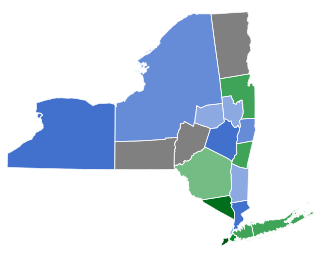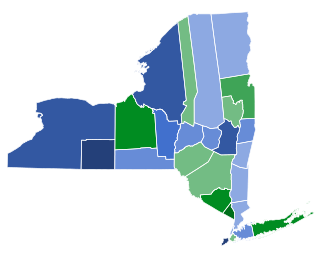
DeWitt Clinton was an American politician and naturalist. He served as a United States senator, as the mayor of New York City, and as the seventh and ninth governor of New York. In the last capacity, he was largely responsible for the construction of the Erie Canal. Clinton was a major candidate for the American presidency in the election of 1812, challenging incumbent James Madison.

John Tayler was a merchant and politician. He served nine years as the lieutenant governor of New York, four months acting as the fifth governor of New York, and also in both houses of the New York State Legislature.

Morgan Lewis was an American lawyer, politician, and military commander. The second son of Francis Lewis, a signer of the Declaration of Independence, Lewis fought in the American Revolutionary War and the War of 1812. He served in the New York State Assembly and the New York State Senate (1811–1814) and was New York State Attorney General (1791–1801) and the third governor of New York (1804–1807).

There have been 91 gubernatorial elections in the state of New York since 1777, with the most recent being held on November 8, 2022. The next election is scheduled to be held on November 3, 2026.

The 1792 New York gubernatorial election was held in April 1792 to elect the Governor and Lieutenant Governor of New York. Incumbent governor George Clinton was narrowly re-elected to a sixth term in office over John Jay, after the votes of Clinton, Ostego, and Tioga counties were disqualified on technicalities.

The 1798 New York gubernatorial election was held in April 1798 to elect the Governor and Lieutenant Governor of New York. Incumbent Governor John Jay was elected to a second term in office over Robert Livingston.

The 1801 New York gubernatorial election was held in April 1801 to elect the Governor of New York. Former Governor George Clinton returned to office, defeating Federalist Stephen Van Rensselaer.

The 1804 New York gubernatorial election was held in April 1804 to elect the Governor of New York. Incumbent Governor George Clinton did not run for re-election, having been nominated for Vice President of the United States in February. In a campaign that blurred partisan divisions, Morgan Lewis defeated Aaron Burr by a landslide margin.

The 1810 New York gubernatorial election was held in April 1810. Governor Daniel D. Tompkins was elected to a second term in office over Jonas Platt.
The 1802 United States Senate special election in New York was held on February 9, 1802, by the New York State Legislature to elect a U.S. Senator to represent the State of New York in the United States Senate.

The 1807 United States Senate election in New York was held on February 3, 1807, by the New York State Legislature to elect a United States Senator to represent the State of New York in the United States Senate.

The 28th New York State Legislature, consisting of the New York State Senate and the New York State Assembly, met from November 6, 1804, to April 10, 1805, during the first year of Morgan Lewis's governorship, in Albany.

The 31st New York State Legislature, consisting of the New York State Senate and the New York State Assembly, met from January 26 to April 11, 1808, during the first year of Daniel D. Tompkins's governorship, in Albany.

The 32nd New York State Legislature, consisting of the New York State Senate and the New York State Assembly, met from November 1, 1808, to March 30, 1809, during the second year of Daniel D. Tompkins's governorship, in Albany.

The 40th New York State Legislature, consisting of the New York State Senate and the New York State Assembly, met from November 5, 1816, to April 15, 1817, during the tenth year of Daniel D. Tompkins's governorship, and while John Tayler was Acting Governor, in Albany.

The 41st New York State Legislature, consisting of the New York State Senate and the New York State Assembly, met from January 27 to April 21, 1818, during the first year of DeWitt Clinton's governorship, in Albany.

The 43rd New York State Legislature, consisting of the New York State Senate and the New York State Assembly, met from January 4 to April 14, 1820, during the third year of DeWitt Clinton's governorship, in Albany.

The 44th New York State Legislature, consisting of the New York State Senate and the New York State Assembly, met from November 7, 1820, to April 3, 1821, during the fourth year of DeWitt Clinton's governorship, in Albany.

In the 1800 United States presidential election, electors could be selected in each state at any time after October 31 and all electors were required to vote on December 3, 1800. In the 1800 United States presidential election in New York The state legislature chose 12 representatives, or electors to the Electoral College on November 6, 1800. Based on the constitutional provision in effect at that time electors cast two votes. The candidate receiving most votes would be President. The runner up would be elected Vice President.















